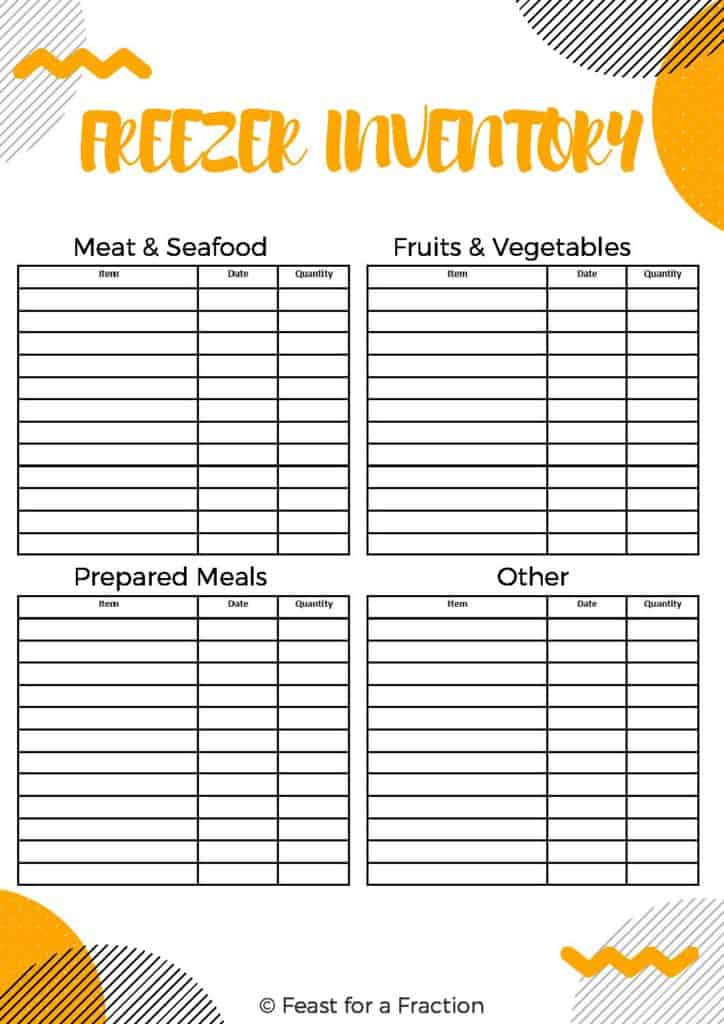
This post contains affiliate links. I earn from qualifying purchases at no cost to you.
One of this most common concerns these days is the price of groceries. Not only are prices going up on everything from eggs to ice cream, sizes of products are shrinking.
So let’s take a moment to talk through some tips for helping you save money on groceries. This list is just the tip of the iceberg, but it’s a good place to start if you’re just starting to pay attention to your grocery spending!
1. Plan Ahead
Take a few minutes to plan your meals for the week. This prevents impulse buys and reduces food waste. Take stock of what you already have in the fridge, freezer and pantry. Use my Freezer and Pantry Inventory printables to keep track.

2. Shop with a List
Stick to your list to avoid buying unnecessary items. It’s like a roadmap for your wallet! Better yet, place your grocery order for pick-up and you’re guaranteed to stick to your list! Wal-Mart, among others, offers free grocery pick up through their app or website.
3. Check Sales and Coupons
When it comes time to create your shopping list, make sure that you are checking store sales flyers every week. By reviewing the flyers first, you can get an idea of your menu for the week based on what is on sale. If chicken is on sale for $1.99/lb, it’s in your best interest to plan meals around chicken or stock up while it is on sale rather than the full price ground beef at $4.99/lb.
Beyond sales flyers, some stores even have digital coupons and rewards through a loyalty program. Make sure to peep the digital coupons for your store and save them. Some stores even have general coupons like Dollar General has $5 off $25 every Saturday.
4. Use Cashback Apps
Some apps offer cashback or rewards for grocery purchases. Check them out to earn extra savings on items you’re already buying.
There are tons of options out there (Fetch Rewards, Swagbucks, Receipt Hog, Rakuten (formerly Ebates), and Upside to name a few).
Ibotta is my absolute favorite, though. You simply add offers to your account, shop and scan your receipt to receive cash back on offers. What I love most, though, is that there is a phone app and a Chrome browser extension that allows you to connect to Wal-Mart and other stores. So, you can order online for pick-up AND still get the rebates!
If you haven’t signed up for Ibotta, use my referral code to get $5 bonus on your first receipt!
5. Shop Seasonal Produce
Seasonal fruits and veggies are usually cheaper and fresher. Plus, they add variety to your meals.
6. Avoid Shopping When Hungry
Shopping on an empty stomach can lead to impulse purchases. Eat a snack beforehand to stay focused.
7. Use Loyalty Programs
Many stores offer loyalty programs with discounts and rewards. Take advantage of them to maximize savings.
8. Buy in Bulk (Wisely)
Buying in bulk can save money, but only if you’ll use it all before it goes bad. Consider splitting bulk purchases with friends or family.
Keep this in mind when it comes to considering a Sam’s Club or Costco membership, too. For example, my family of 2 doesn’t need 5 pounds of parmesan cheese, but I got it for $1/lb. So, I repackaged it into quart-size freezer bags, shared some with family, froze and I pull out one bag at a time as needed. This was over a year ago and we’re still working through it!
9. Compare Unit Prices
Sometimes the bigger package isn’t always the better deal. Check the unit price to find the best value.
10. Cook at Home
Eating out adds up quickly. Cooking at home not only saves money but also allows you to control ingredients and portions.
That doesn’t mean that it needs to be a complicated or that you need to make everything from scratch. Grilled cheese sandwiches and a can of green beans is a balanced meal and incredibly frugal.
Pay attention to the foods that you find yourself eating out most and try re-creating it at home.
11. Meal Prep
Spend a couple of hours each week prepping meals in advance. It saves time and money during busy weekdays.
I don’t know if you struggle with this, too, but I wind up wasting produce because it goes bad in the fridge. Take that extra 10 minutes to clean and de-stem the grapes or cut the celery and store in a container so that you have it handy and everyone is more likely to go for it when they are hungry!
12. Utilize Leftovers
Get creative with leftovers to make new meals. It’s like a free meal waiting in your fridge!
- Teriyaki Ham Stir-Fry (using leftover ham and/or rice!)
- Easy Quiche Recipe (perfect for any leftover meat or vegetables you have on hand!)
13. Freeze Excess
If you have too much of something, freeze it before it goes bad. It extends its shelf life and prevents waste. You’ll learn what foods hold up best to freezing. Below are some of my favorites:
14. Grow Your Own Produce
If you have space, consider growing herbs or veggies at home. It’s rewarding and saves money in the long run. You can even re-grow things like green onion, celery and romaine lettuce from your scraps!

I also love my AeroGarden hydroponic growing system. It allows me to grow herbs year-round and it even gives me reminders when it needs plant food and water.
15. Limit Convenience Foods
Pre-cut fruits, pre-packaged salads, and other convenience foods come with a premium price. Opt for whole ingredients instead.
16. Shop Online
Online grocery shopping can help you stick to your budget by avoiding impulse buys and allowing you to easily compare prices.
17. Skip Bottled Water
Invest in a reusable water bottle and a water filter to save money on bottled water. It’s better for your wallet and the environment.
18. Reduce Meat Consumption
Meat is often one of the most expensive items on your grocery list. Try incorporating more plant-based meals to save money. We’ve instituted a Meatless Monday into meal planning and it really isn’t that bad. Grilled cheese sandwiches with soup is one of my favorites for a quick and easy meatless dinner.
19. Make Your Own Snacks
Skip the pricey packaged snacks and make your own at home. Think homemade granola bars, popcorn, or trail mix.
20. Buy Generic Brands
Often, generic brands are just as good as name brands but come with a lower price tag. Give them a try!
21. Shop Less Frequently
The more you visit the store, the more tempted you might be to buy unnecessary items. Try to limit your trips to once a week.
22. Look for Markdowns
Whether it is a clearance endcap or discounts on fresh bread at the end of the day, be on the lookout. Even better, ask when your stores generally mark down perishable food like meat and milk. For instance, my Aldi marks down meat on Tuesday mornings. Time it right and you can get those glorious 50% deals!
23. DIY Staples
Instead of buying pre-made sauces or dressings, try making your own at home. It’s often cheaper and healthier, from pantry staple ingredients. Another frugal tip is to stock up on condiment packets when you do eat out or while you’re at the gas station. Rather than committing to buying a whole bottle of soy sauce, you’ll have a stash of packets in a drawer or ziplock bag.
I’m also a huge fan of making spice blends at home. Whether you buy spices from bulk bins or dehydrate your own, mixing up your own spice blends is fun, frugal and allows you to get creative with flavors.

24. Join a CSA
Community Supported Agriculture (CSA) programs offer fresh produce directly from local farms at a discounted price. It’s a win-win for you and the farmers. I’ve participated in a CSA the past few summers and it has been a great way to try new produce that I wouldn’t normally purchase on my own. Yes, it does require you to be a little flexible and creative in the kitchen, but if you’re up for the adventure it is a great deal for how much produce you get for your share!
You can use this CSA Locator to find options in your area.
25. Practice Patience
Lastly, remember that saving money on groceries takes time and practice. Be patient with yourself as you develop new habits and strategies!
Let me know your favorite ideas for saving money on groceries! Leave a comment below!



